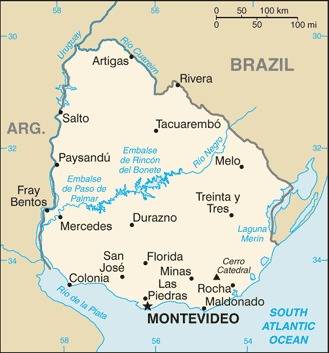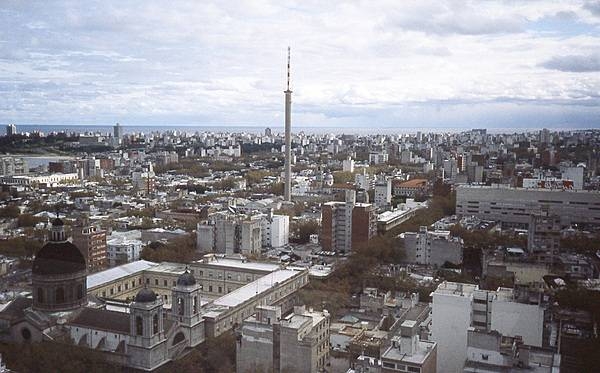35 Uruguay

Nine equal horizontal stripes of white (top and bottom) alternating with blue. A white square in the upper hoist-side corner with a yellow sun bearing a human face (delineated in black) known as the Sun of May with 16 rays that alternate between triangular and wavy. The stripes represent the nine original departments of Uruguay. The sun symbol evokes the legend of the sun breaking through the clouds on 25 May 1810 as independence was first declared from Spain (Uruguay subsequently won its independence from Brazil). The sun features are said to represent those of Inti, the Inca god of the sun.
Flag courtesy of the CIA World Factbook

Map courtesy of CIA World Factbook

Aerial view of Montevideo showing the Sacred Heart Church in the left foreground. The adjoining building was originally a seminary but today is a school.
Photo courtesy of the CIA World Factbook
Government
According to Britannica, the government operates under the 1966 constitution, as amended following the period of military rule (1973–85). Amendments in 1996 separated municipal and national elections and changed the balloting system for the presidential election. A president and a Council of Ministers hold executive power, and a vice president serves as president of the bicameral legislature. The president and vice president are elected to five-year terms and may not seek immediate reelection. If no candidate receives a majority vote in a presidential election, a runoff election (ballotage) is held to decide between the two leading candidates. The General Assembly consists of the 31-member Senate and the 99-member Chamber of Representatives, whose members are elected to five-year terms by direct popular vote.
Local administration is provided by the country’s 19 departamentos, each of which has a departmental board (legislature) and an intendente municipal, a chief executive who acts as a combined departmental governor and mayor for the departmental capital.
At the head of the judiciary is the Supreme Court, composed of five justices who are elected by the General Assembly to 10-year terms and are eligible for reelection five years after their previous term ends. The Appellate Tribunals, each composed of three judges, form the next-highest judicial level, followed by the Courts of Record. The Supreme Court justices select Appellate Tribunal judges for confirmation by the Senate. Prison conditions are poor yet better than those in many other Latin American countries. Some trials last for years because of delays in the justice system.
National Directorate of Civil Aviation and Aeronautical Infrastructure (DINACIA)
Decree No. 21/999 of January 26, 1999 establishes that the National Directorate of Civil Aviation and Aeronautical Infrastructure (DINACIA) is the aeronautical authority referred to in the Aeronautical Code and the other applicable regulations on the matter; it also regulates its organization and operation. The National Budget Law No. 17,296 of February 21, 2001, in its article 106 merges the executing units corresponding to the National Directorate of Civil Aviation and Aeronautical Infrastructure, the General Directorate of Civil Aviation and the General Directorate of Aeronautical Infrastructure.
Airspace
SkyVector – Google Maps – ADS-B Exchange
ICAO countries publish an Aeronautical Information Publication (AIP). This document is divided into three parts: General (GEN), En Route (ENR) and Aerodromes (AD). ENR 1.4 details the types of airspace classes they chose to adopt from classes A through G.
Drone Regulations
Uruguay (UY) Advisory Circular – CA.UY.PEL.07.02 – ISSUANCE OF A REMOTELY OPERATED AERIAL DEVICE OPERATOR PERMIT.
Study topics for free exam DAOD-RPA Operator.
LT-PEL-104-006 Translated into English by Google
Translations
Translations of any materials into English are intended solely as a convenience to the public and are not legally binding. The author has merely attempted to provide a Google translation of the original material to English for convenience. Due to the nuances in translating to a foreign language, several differences may exist so before using for any work or pleasure please have the document translated by a professional service!
STUDY TOPICS FOR FREE EXAM
LICENSE: DAOD OPERATOR
SUBJECT: MULTIROTOR QUALIFICATION – FIXED WING
1.1. GENERAL KNOWLEDGE OF DEVICES.
Types of DAOD-RPA.
DAOD-RPA cell.
Powertrain.
Batteries.
On-board equipment – sensors.
Device control systems.
Control station.
Safety systems.
1.2. METEOROLOGY
The Earth’s atmosphere
Pressure, temperature, density
Altimetry
Pressure and wind
Clouds and associated climatology
Fronts
Visibility
Meteorological information (METAR – Speci. – TAF)
Solar storms – KP Index
1.3. PERFORMANCE AND PRINCIPLES OF FLIGHT.
Aerodynamics
Airflow through an aerodynamic profile.
Forces acting in flight.
Flight controls.
Stability.
Flight profile.
Weight limitations.
Weight and balance.
1.4. AIR NAVIGATION.
The Earth – Geographic coordinates.
Time zones.
Aeronautical charts.
Autonomous – non-autonomous air navigation.
Satellite positioning and navigation system. GNSS
Course – Heading – Route – Bearing.
AIP – Controlled – non-controlled airspace.
Prohibited, Restricted, Dangerous Zones.
Notams.
VLOS – BVLOS – EVLOS.
1.5. OPERATION.
Flight planning.
Use of Checklist.
Normal and emergency procedures
Risk assessment – SMS.
Dangerous goods
1.6. HUMAN FACTORS.
The human factor.
Situational awareness.
Communication.
Workload and human performance.
Teamwork, leadership.
Health aspects that may affect the piloting of DAOD-RPA.
Accident prevention.
1.7. REGULATIONS.
Aeronautical Code. Articles 122, 200, 202, 207, and 211 to 216.
Resolution 291/2014.
Decree 015/2024 (Aerial work).
Decree 260/2018 (Sensors).
AIP.
LAR 91 (Appendix M)
Circular CA.UY.PEL.07.00 (Issuance of DAOD Operator Permit)
Circular CA.UY.PEL.02.00 (Renewal of DAOD Operator Permit)
Circular CA.UY.PEL.03.00 (DAOD Instructor)
Bibliography
General UAS Flight Knowledge – AESA (Pages 51-139)
(Pages 51-139, the first part, Regulatory Concepts, does not apply.)
IAA Private Pilot Manual – Chapter 7 (Meteorology)
MET GUIDE – Aeronautical Meteorological Information – Inumet.
Circulars are available on the Dinacia website.
Drone Pilot (RPAS) – Paraninfo.
Basic Meteorology for Drones – Francesco Padovano – Paraninfo.
Advanced Air Mobility (AAM) Regulations & Policies
None found by the author.
However, should you, the reader, happen to stumble across something to the contrary, please email the author at FISHE5CA@erau.edu and you may be mentioned in the ACKNOWLEDGEMENTS section of this book by way of thanks for contributing to this free eBook!
Advanced Air Mobility (AAM) News
2025
Video courtesy of Advanced Air Mobility Institute from the January 2025 Global AAM Forum. Complete session for Day 1 of this Forum is available on the Advanced Air Mobility Institute YouTube Channel
2022 – Airports In Argentina, Brazil, Ecuador & Uruguay Could Become eVTOL Hubs
Short Essay Questions
Scenario-Based Question
You have been hired by a Drone Startup Company. Your boss has immediately assigned this job to you.
They need you to prepare a one-page memo detailing the legalities of using a drone in Montevideo, pictured above.
They need you to mention any national laws and local ordinances.
They specifically want to know what airspace (insert pictures) you will be operating in and whether or not you need an airspace authorization.
Does it matter whether or not you are a citizen of the country?
Lastly, there is a bonus for you if, as you scroll through this chapter, you find any typos or broken links!
Short Essay Questions
- What are the drone categories?
- How is registration addressed?
- How is remote ID addressed?
- What are the model aircraft rules?
- What are the commercial drone rules?
- Are there waivers or exemptions to the rules? If so, for what?
- Would you share a link to an interactive airspace map?
- How is BVLOS addressed?
- How can you fly drones at night?
- How can you fly drones over people?
- Where do you find drone NOTAMs?
- What are the rules for drone maintenance?
- What are the rules for an SMS program?
- What are some unique rules not mentioned above?
- What are the C-UAS rules?
- What are the AAM rules?

